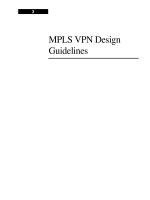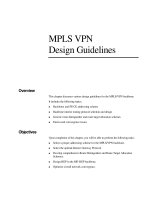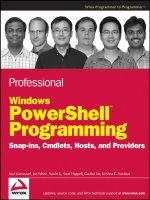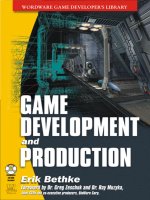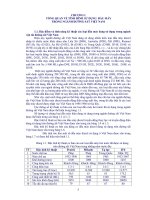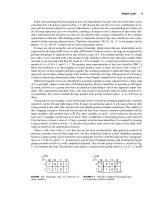Tài liệu COMPLETE DIGITAL DESIGN P1 ppt
Bạn đang xem bản rút gọn của tài liệu. Xem và tải ngay bản đầy đủ của tài liệu tại đây (496.88 KB, 30 trang )
COMPLETE DIGITAL DESIGN
-Balch.book Page i Thursday, May 15, 2003 3:46 PM
This page intentionally left blank.
COMPLETE
DIGITAL DESIGN
A Comprehensive Guide to Digital Electronics
and Computer System Architecture
Mark Balch
McGRAW-HILL
New York Chicago San Francisco
Lisbon London Madrid Mexico CityMilan
New Delhi San Juan Seoul Singapore
Sydney Toronto
-Balch.book Page iii Thursday, May 15, 2003 3:46 PM
Copyright © 2003 by The McGraw-Hill Companies, Inc. All rights reserved. Manufactured in the United States of
America. Except as permitted under the United States Copyright Act of 1976, no part of this publication may be
reproduced or distributed in any form or by any means, or stored in a database or retrieval system, without the prior
written permission of the publisher.
0-07-143347-3
The material in this eBook also appears in the print version of this title: 0-07-140927-0
All trademarks are trademarks of their respective owners. Rather than put a trademark symbol after every occur-
rence of a trademarked name, we use names in an editorial fashion only, and to the benefit of the trademark
owner, with no intention of infringement of the trademark. Where such designations appear in this book, they
have been printed with initial caps.
McGraw-Hill eBooks are available at special quantity discounts to use as premiums and sales promotions, or for
use in corporate training programs. For more information, please contact George Hoare, Special Sales, at
or (212) 904-4069.
TERMS OF USE
This is a copyrighted work and The McGraw-Hill Companies, Inc. (“McGraw-Hill”) and its licensors reserve all
rights in and to the work. Use of this work is subject to these terms. Except as permitted under the Copyright Act
of 1976 and the right to store and retrieve one copy of the work, you may not decompile, disassemble, reverse
engineer, reproduce, modify, create derivative works based upon, transmit, distribute, disseminate, sell, publish
or sublicense the work or any part of it without McGraw-Hill’s prior consent. You may use the work for your
own noncommercial and personal use; any other use of the work is strictly prohibited. Your right to use the work
may be terminated if you fail to comply with these terms.
THE WORK IS PROVIDED “AS IS”. McGRAW-HILL AND ITS LICENSORS MAKE NO GUARANTEES
OR WARRANTIES AS TO THE ACCURACY, ADEQUACY OR COMPLETENESS OF OR RESULTS TO BE
OBTAINED FROM USING THE WORK, INCLUDING ANY INFORMATION THAT CAN BE ACCESSED
THROUGH THE WORK VIA HYPERLINK OR OTHERWISE, AND EXPRESSLY DISCLAIM ANY WAR-
RANTY, EXPRESS OR IMPLIED, INCLUDING BUT NOT LIMITED TO IMPLIED WARRANTIES OF
MERCHANTABILITY OR FITNESS FOR A PARTICULAR PURPOSE. McGraw-Hill and its licensors do not
warrant or guarantee that the functions contained in the work will meet your requirements or that its operation
will be uninterrupted or error free. Neither McGraw-Hill nor its licensors shall be liable to you or anyone else for
any inaccuracy, error or omission, regardless of cause, in the work or for any damages resulting therefrom.
McGraw-Hill has no responsibility for the content of any information accessed through the work. Under no cir-
cumstances shall McGraw-Hill and/or its licensors be liable for any indirect, incidental, special, punitive, conse-
quential or similar damages that result from the use of or inability to use the work, even if any of them has been
advised of the possibility of such damages. This limitation of liability shall apply to any claim or cause whatso-
ever whether such claim or cause arises in contract, tort or otherwise.
DOI: 10.1036/0071433473
ebook_copyright 8 x 10.qxd 8/27/03 9:20 AM Page 1
for Neil
-Balch.book Page v Thursday, May 15, 2003 3:46 PM
This page intentionally left blank.
CONTENTS
Preface xiii
Acknowledgments xix
PART 1 Digital Fundamentals
Chapter 1 Digital Logic . . . . . . . . . . . . . . . . . . . . . . . . . . . . . . . . . . . . . . . . . . . . . . . . . . .3
1.1 Boolean Logic /
3
1.2 Boolean Manipulation /
7
1.3 The Karnaugh map /
8
1.4 Binary and Hexadecimal Numbering /
10
1.5 Binary Addition /
14
1.6 Subtraction and Negative Numbers /
15
1.7 Multiplication and Division /
17
1.8 Flip-Flops and Latches /
18
1.9 Synchronous Logic /
21
1.10 Synchronous Timing Analysis /
23
1.11 Clock Skew /
25
1.12 Clock Jitter /
27
1.13 Derived Logical Building Blocks /
28
Chapter 2 Integrated Circuits and the 7400 Logic Families. . . . . . . . . . . . . . . . . . . . .33
2.1 The Integrated Circuit /
33
2.2 IC Packaging /
38
2.3 The 7400-Series Discrete Logic Family /
41
2.4 Applying the 7400 Family to Logic Design /
43
2.5 Synchronous Logic Design with the 7400 Family /
45
2.6 Common Variants of the 7400 Family /
50
2.7 Interpreting a Digital IC Data Sheet /
51
Chapter 3 Basic Computer Architecture . . . . . . . . . . . . . . . . . . . . . . . . . . . . . . . . . . . .55
3.1 The Digital Computer /
56
3.2 Microprocessor Internals /
58
3.3 Subroutines and the Stack /
60
3.4 Reset and Interrupts /
62
3.5 Implementation of an Eight-Bit Computer /
63
3.6 Address Banking /
67
3.7 Direct Memory Access /
68
3.8 Extending the Microprocessor Bus /
70
3.9 Assembly Language and Addressing Modes /
72
-Balch.book Page vii Thursday, May 15, 2003 3:46 PM
For more information about this title, click here.
Copyright 2003 by The McGraw-Hill Companies, Inc. Click Here for Terms of Use.
viii
CONTENTS
Chapter 4 Memory. . . . . . . . . . . . . . . . . . . . . . . . . . . . . . . . . . . . . . . . . . . . . . . . . . . . . .77
4.1 Memory Classifications /
77
4.2 EPROM /
79
4.3 Flash Memory /
81
4.4 EEPROM /
85
4.5 Asynchronous SRAM /
86
4.6 Asynchronous DRAM /
88
4.7 Multiport Memory /
92
4.8 The FIFO /
94
Chapter 5 Serial Communications. . . . . . . . . . . . . . . . . . . . . . . . . . . . . . . . . . . . . . . . .97
5.1 Serial vs. Parallel Communication /
98
5.2 The UART /
99
5.3 ASCII Data Representation /
102
5.4 RS-232 /
102
5.5 RS-422 /
107
5.6 Modems and Baud Rate /
108
5.7 Network Topologies /
109
5.8 Network Data Formats /
110
5.9 RS-485 /
112
5.10 A Simple RS-485 Network /
114
5.11 Interchip Serial Communications /
117
Chapter 6 Instructive Microprocessors and Microcomputer Elements . . . . . . . . . .121
6.1 Evolution /
121
6.2 Motorola 6800 Eight-bit Microprocessor Family /
122
6.3 Intel 8051 Microcontroller Family /
125
6.4 Microchip PIC® Microcontroller Family /
131
6.5 Intel 8086 16-Bit Microprocessor Family /
134
6.6 Motorola 68000 16/32-Bit Microprocessor Family /
139
PART 2 Advanced Digital Systems
Chapter 7 Advanced Microprocessor Concepts . . . . . . . . . . . . . . . . . . . . . . . . . . . . .145
7.1 RISC and CISC /
145
7.2 Cache Structures /
149
7.3 Caches in Practice /
154
7.4 Virtual Memory and the MMU /
158
7.5 Superpipelined and Superscalar Architectures /
161
7.6 Floating-Point Arithmetic /
165
7.7 Digital Signal Processors /
167
7.8 Performance Metrics /
169
Chapter 8 High-Performance Memory Technologies. . . . . . . . . . . . . . . . . . . . . . . . .173
8.1 Synchronous DRAM /
173
8.2 Double Data Rate SDRAM /
179
8.3 Synchronous SRAM /
182
8.4 DDR and QDR SRAM /
185
8.5 Content Addressable Memory /
188
-Balch.book Page viii Thursday, May 15, 2003 3:46 PM
CONTENTS
ix
Chapter 9 Networking. . . . . . . . . . . . . . . . . . . . . . . . . . . . . . . . . . . . . . . . . . . . . . . . . .193
9.1 Protocol Layers One and Two /
193
9.2 Protocol Layers Three and Four /
194
9.3 Physical Media /
197
9.4 Channel Coding /
198
9.5 8B10B Coding /
203
9.6 Error Detection /
207
9.7 Checksum /
208
9.8 Cyclic Redundancy Check /
209
9.9 Ethernet /
215
Chapter 10 Logic Design and Finite State Machines . . . . . . . . . . . . . . . . . . . . . . . . .221
10.1 Hardware Description Languages /
221
10.2 CPU Support Logic /
227
10.3 Clock Domain Crossing /
233
10.4 Finite State Machines /
237
10.5 FSM Bus Control /
239
10.6 FSM Optimization /
243
10.7 Pipelining /
245
Chapter 11 Programmable Logic Devices . . . . . . . . . . . . . . . . . . . . . . . . . . . . . . . . . .249
11.1 Custom and Programmable Logic /
249
11.2 GALs and PALs /
252
11.3 CPLDs /
255
11.4 FPGAs /
257
PART 3 Analog Basics for Digital Systems
Chapter 12 Electrical Fundamentals . . . . . . . . . . . . . . . . . . . . . . . . . . . . . . . . . . . . . .267
12.1 Basic Circuits /
267
12.2 Loop and Node Analysis /
268
12.3 Resistance Combination /
271
12.4 Capacitors /
272
12.5 Capacitors as AC Elements /
274
12.6 Inductors /
276
12.7 Nonideal RLC Models /
276
12.8 Frequency Domain Analysis /
279
12.9 Lowpass and Highpass Filters /
283
12.10 Transformers /
288
Chapter 13 Diodes and Transistors . . . . . . . . . . . . . . . . . . . . . . . . . . . . . . . . . . . . . . .293
13.1 Diodes /
293
13.2 Power Circuits with Diodes /
296
13.3 Diodes in Digital Applications /
298
13.4 Bipolar Junction Transistors /
300
13.5 Digital Amplification with the BJT /
301
13.6 Logic Functions with the BJT /
304
13.7 Field-Effect Transistors /
306
13.8 Power FETs and JFETs /
309
-Balch.book Page ix Thursday, May 15, 2003 3:46 PM
x
CONTENTS
Chapter 14 Operational Amplifiers . . . . . . . . . . . . . . . . . . . . . . . . . . . . . . . . . . . . . . .311
14.1 The Ideal Op-amp /
311
14.2 Characteristics of Real Op-amps /
316
14.3 Bandwidth Limitations /
324
14.4 Input Resistance / 325
14.5 Summation Amplifier Circuits / 328
14.6 Active Filters / 331
14.7 Comparators and Hysteresis / 333
Chapter 15 Analog Interfaces for Digital Systems . . . . . . . . . . . . . . . . . . . . . . . . . . .339
15.1 Conversion between Analog and Digital Domains / 339
15.2 Sampling Rate and Aliasing / 341
15.3 ADC Circuits / 345
15.4 DAC Circuits / 348
15.5 Filters in Data Conversion Systems / 350
PART 4 Digital System Design in Practice
Chapter 16 Clock Distribution . . . . . . . . . . . . . . . . . . . . . . . . . . . . . . . . . . . . . . . . . . .355
16.1 Crystal Oscillators and Ceramic Resonators / 355
16.2 Low-Skew Clock Buffers / 357
16.3 Zero-Delay Buffers: The PLL / 360
16.4 Frequency Synthesis / 364
16.5 Delay-Locked Loops / 366
16.6 Source-Synchronous Clocking / 367
Chapter 17 Voltage Regulation and Power Distribution . . . . . . . . . . . . . . . . . . . . . .371
17.1 Voltage Regulation Basics / 372
17.2 Thermal Analysis / 374
17.3 Zener Diodes and Shunt Regulators / 376
17.4 Transistors and Discrete Series Regulators / 379
17.5 Linear Regulators / 382
17.6 Switching Regulators / 386
17.7 Power Distribution / 389
17.8 Electrical Integrity / 392
Chapter 18 Signal Integrity. . . . . . . . . . . . . . . . . . . . . . . . . . . . . . . . . . . . . . . . . . . . . .397
18.1 Transmission Lines / 398
18.2 Termination / 403
18.3 Crosstalk / 408
18.4 Electromagnetic Interference / 410
18.5 Grounding and Electromagnetic Compatibility / 413
18.6 Electrostatic Discharge / 415
Chapter 19 Designing for Success . . . . . . . . . . . . . . . . . . . . . . . . . . . . . . . . . . . . . . . .419
19.1 Practical Technologies / 420
19.2 Printed Circuit Boards / 422
-Balch.book Page x Thursday, May 15, 2003 3:46 PM
